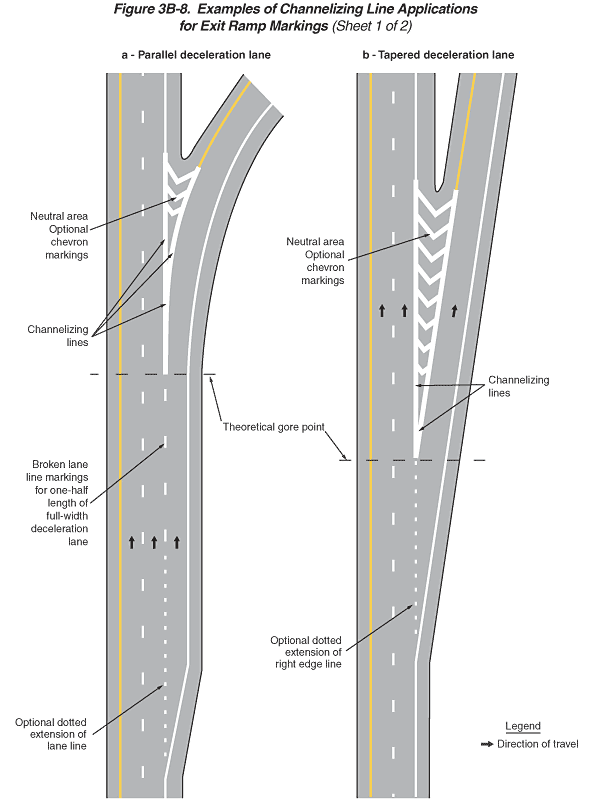|

Figure 3B-8. Examples of Channelizing Line Applications for Exit
Ramp Markings (Sheet 1 of 2)
This figure illustrates three examples of channelizing line applications
for exit ramp markings, (a), (b), and (c). The figure is composed
of two sheets.
- Sheet 1 of the figure shows two vertical highways, examples
(a) and (b):
- Example (a), parallel deceleration lane, shows the two lanes
of one direction of a divided highway. Arrows indicate that the
direction of travel is from the bottom of the figure to the top.
A solid yellow line is to the left of the left most through lane,
a solid white line separates the rightmost travel lane from the
right shoulder, and the through lanes are separated from each
other by a broken white line. Near the bottom of the figure, a
deceleration lane is added to the right of the two through lanes,
leading to a right exit ramp. The deceleration lane runs parallel
to the through lanes and is separated from them by a dotted and
then broken white line. Notes show "broken lane markings
for one-half length of full-width deceleration lane" and
"optional dotted extension of lane line." At the "theoretical
gore point," the broken white line becomes wide solid white
"channelizing lines" that then becomes a white triangle
in front of the gore. A note identifies this as a "neutral
area" with white "optional chevron markings" added.
The exit ramp curves away to the right.
- Example (b), tapered deceleration lane, shows the two lanes
of one direction of a divided highway. Arrows indicate that the
direction of travel is from the bottom of the figure to the top.
A solid yellow line is to the left of the leftmost through lanes,
a solid white line separates the rightmost travel lane from the
right shoulder , and the through lanes are separated from each
other by a broken white line. Near the bottom of the figure, a
deceleration lane is added to the right of the two through lanes,
leading to a right exit ramp. The tapered deceleration lane immediately
angles away from the through lanes and is separated from them
by a dotted white line. A note shows this as an "optional
dotted extension of right edge line." At the "theoretical
gore point," the dotted white line becomes wide solid white
"channelizing lines" and another wide solid white line
angles off along the left edge of the exit ramp, forming an elongated
white triangle in front of the gore. A note identifies this as
a "neutral area" with white "optional chevron markings"
added. The exit ramp angles off to the right.
- A legend shows a black arrow indicating the direction of travel
in the lanes.
Continue to: Sheet 2
Back
to Chapter 3B
|

